Fdic New Deal
- Fdic New Deal
- Fdic Complaint Process
- Fdic Consumer Complaint Policy
- Fdic New Deal Relief Recovery Reform
- Sec New Deal
- Federal Deposit Insurance Corporation New Deal
- When Franklin Roosevelt promised the American people a 'new deal,' he focused on what's known as the three R's: Relief, Recovery, and Reform. Reform of the nation's financial system was central to.
- FDIC is one of the longest-lasting and greatest accomplishments of the New Deal. Its policies have changed little over the years. Notably, the upper limit on the amount insured per account has risen and regulators have come to favor bank mergers over the bankruptcy of major banking houses.
- Start studying The New Deal-FDIC. Learn vocabulary, terms, and more with flashcards, games, and other study tools. Start a free trial of Quizlet Plus by Thanksgiving Lock in 50% off all year Try it free.

I know everyone is talking about stock market all time high’s right now, but its hard for me to hear them over the sound of hundreds of trillions in unfunded liabilities. Unfunded liabilities are debts payable at some point in the future that are currently not covered by cash or assets held on the balance sheet. The US has a growing number of unfunded liabilities (to the tune of over $200 TRILLION) and we will cover most of them, but for the purposes of this we only need to talk about FDIC.
As a part of the banking reform under the FDR new deal, as we discussed yesterday, the Glass-Steagall act limited commercial bank securities activity and regulated speculation. It also established the Federal Deposit Insurance Corporation which insured every banking deposit in the US with up to $2,500. This was an attempt to shore up bank reserves and stem the tide of bank runs happening across the country.
One of the important events during his presidency was the establishment of the Federal Deposit Insurance Corporation. As part of FDR's New Deal Programs that encompassed his strategies of Relief, Recovery and Reform to combat the problems and effects of the Great Depression. 1929-1945: Depression & WW2. Start studying The New Deal-FDIC. Learn vocabulary, terms, and more with flashcards, games, and other study tools. Start a free trial of Quizlet Plus by Thanksgiving Lock in 50% off all year Try it free.
Over the years since the FDIC’s inception, the total value of insurance has increased up to $250,000 (thanks inflation) and is now only offered to member banks. The way the system was supposed to work is as a private insurance fund. Member banks pay into a shared pool of funds which are drawn upon in the event of a crisis.
However, as risky lending practices have ramped up over the years thanks to loose fiscal policy and the recent 0% reserve requirement for banks the value of this fund has become an aberration. The idea of FDIC being “private insurance” is all but laughable. On a good day, the Deposit Insurance Fund has about $100 Billion on hand. Most days, Banks have around $15 Trillion in insured deposits. Yes you read that right. FDIC could never cover even one percent of outstanding deposits…on a good day.
A real insurance fund would have to underwrite risk of payout into its policy but the FDIC takes into account none of the consequences cheap credit and loose money have had on the stability of the banking system. A cascade of liquidation could easily wipe out not only the cash banks do have on hand, but also every cent of the insurance fund.

This is where the lender of last resort comes in. The FDIC has a $100 billion line of credit with the US Treasury, and given past precedents you can almost guarantee that line of credit would be extended indefinitely in the event of a crisis. But wait, you say, the treasury is also insolvent, does the US not have $26 TRILLION in debt and growing by the second? To which I say, certainly, and don’t forget about the hundreds of Trillions in unfunded liabilities!
This is what’s so great about having a lender of last resort. The banks pay into insurance funds to shore up their deposits, the treasury can back that insurance fund with a line of credit, and the Fed can create infinite amounts of new money and credit to back it all up. You see, at the end of the day the idea that FDIC is “insurance” is laughable.
We’re the liquidation ever allowed to run its course, the Fed would assuredly step in and provide “unlimited liquidity” to meet deposit demand for member banks. FDIC is not insurance at all, but rather a clever way to link your checking and savings accounts to the money printer.
The illusion of safety.
Fdic New Deal
-Collin

Fdic Complaint Process
Book of the Month:
Fdic Consumer Complaint Policy
The Ethics of Money Production by Jorg Guido Huulsman-“The use of paper money carries the risk of total and permanent value annihilation. This risk does not exist in the case of commodity money, which always carries a positive price and which can therefore always be re-monetized”

Fdic New Deal Relief Recovery Reform
WTF1971.com is a participant in the Amazon Services LLC Associates Program, an affiliate advertising program designed to provide a means for sites to earn advertising fees by advertising and linking to (“WTF1971.com” (amazon.com, or endless.com, MYHABIT.com, SmallParts.com, or AmazonWireless.com).
Definition and Summary of the Federal Deposit Insurance Corporation
Summary and Definition: The Federal Deposit Insurance Corporation (FDIC) was created by the Glass-Steagall Act, also known as the Banking Act of 1933, as an additional measure to restore confidence in the banks following the banking crisis during the Great Depression. The Federal Deposit Insurance Corporation (FDIC) insured depositors against the loss of up to $5,000 of their deposits if their bank should collapse.
Sec New Deal

Federal Deposit Insurance Corporation New Deal
Federal Deposit Insurance Corporation (FDIC)
Franklin D Roosevelt was the 32nd American President who served in office from March 4, 1933 to April 12, 1945. One of the important events during his presidency was the establishment of the Federal Deposit Insurance Corporation. as part of FDR's New Deal Programs that encompassed his strategies of Relief, Recovery and Reform to combat the problems and effects of the Great Depression.